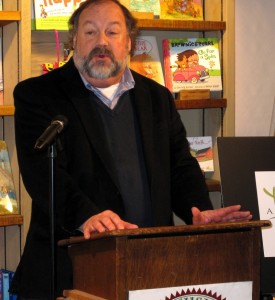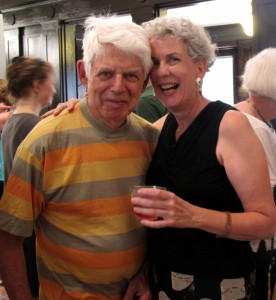The Southern Vermont creative world finds deep connections to the New York arts scene — and vice versa.
By Arlene Distler

Eugene Uman, director of the Vermont Jazz Center, maintains ties with New York City as “one of the best ways to keep your finger on the pulse.”
As Sharon Olds, New York poet, put it the year she appeared at the Brattleboro Literary Festival, “I lift mine hills to the hills from whence my deliverance comes.”
New Yorkers have long eyed the lands to the north with yearning –at least since the 40’s and 50’s. That was the era of Scott Nearing and a few hearty pioneering “flatlanders” who decided to chuck it all and head for the hills. This chapter of Vermont’s history is well documented in literature and film, most recently in Vermont filmmaker Nora Jacobson’s documentary, ’The Vermont Movie,’ a six-part social, geographic, and political history. Jacobson documents her own family’s migration north in an interview with her father, Nicholas Jacobson, an intellectual who came seeking an “alternative lifestyle.”
What was a trickle in those years turned into a full-on torrent in the late 60’s, with the “back-to-the-land” movement — a brave experiment that gripped the counter-culture movement, and changed Vermont forever. Communes sprung up in southern Vermont, and many communards came with intellectual and artistic backgrounds, likely due to southern Vermont’s proximity to the large cities of the northeast. Packer-Corners Farm was peopled by renegades from Boston University; many of the individual “homesteaders” in rural towns such as Readsboro, Guilford, Putney were and are artists, writers, and crafters who found the fresh country air brightened their colors, sharpened their wits and made nimble their hands. Abandoning the “rat race” made for time to think, write, make. In between of course cutting, splitting, loading wood, planting, gathering, “putting by” and all the honorable earthy good works the counter culture was hungry for.
The upshot is that southern Vermont has become a rich arts-centered culture. As artists brought other artists, crafts people brought other crafts people and made committed lives among the maples and meandering brooks, Vermont took on a new character.

Steve Stetler, director at Weston Playhouse: “Where we are in Vermont is everything New York isn’t.”
A recent trip to New York highlighted for me how sympathetic is the arts culture of apple-laden southern Vermont with the Big Apple. As I sat watching “After Midnight,” a Broadway show that spotlights jazz from the time of the Cotton Club, I realized I was in my comfort zone – thanks to the Vermont Jazz Center. After years of attending performances at VJC in Brattleboro I thought how lucky to have access to this music – at affordable prices – all year round!
Run by Eugene Uman, the VJC brings in jazz musicians whose “grooves” range from the classics to more modern “fusion” and world beat.
Hailing from New York, where he attended Queens College’s prestigious jazz program, Eugene says he keeps his bonafides by regularly going into “the city.” Explains Uman, “At first I’d have musicians that were friends of the founder, Atilla Zola, but I knew I wanted to expand. I would make New York field trips, attending small festivals such as the International Association of Jazz Educators (IAJE). Or the Winter Jazz Festival, a showcase of new musical talent, held in Greenwich Village. I met cutting edge musicians and knew I wanted them here.” He continues, “Going to New York is one of the best ways to put your finger on the pulse. It’s important to stay current, as a presenter. But I also pride myself on not eschewing those who play the old standards. Jazz is a music that has a rich heritage. I feel even the most current jazz pays homage to that lineage through improvisational language and historical styles. “

The Brattleboro Museum and Art Center maintains close ties with New York City through its curator, Mara Williams, shown here with artist Wolf Kahn.
Steve Stetler, a producing director and guiding light at Weston Playhouse, explains his appreciation of southern Vermont’s New York connection this way: “If you are trying to bring the highest level of artistry to a production, as we are, the greatest concentration of artists are in New York.” In addition, he says, ” New York provides us with a base of supporters––fans and funders.”
He’s not the only one. There’s no doubt that wealth has accumulated in the cities, far outstripping any kind of economic growth in rural areas. The cities have proven to be a blessed source of funders for southern Vermont arts non-profits. Southern Vermont Arts Center, Dorset Theater Playhouse, Weston Playhouse, Vermont Jazz Center are just a few southern Vermont arts institutions that are kept viable and thriving in no small part due to New York City-based lovers of the arts.
Bronwyn Sims and Patrick Donnelly head up Strong Coffee, a theater company based in the very small town of Guilford, Vt., a stone’s throw from Brattleboro.
Bronwyn’s special talent is physical theater which has a long European tradition but is fairly new in this country.
Having spent their formative career years in New York, they still have “plenty of friends there” with whom they collaborate.
The two “recharge their batteries,” they say, by making frequent trips to New York where they teach, take workshops, see shows, and perform, calling themselves “advanced couch-surfers.”
Animated, energetic, fresh-faced, Bronwyn explains they “fell in love with Vermont” when the two spent their honeymoon in Stowe. They then received an invitation they couldn’t refuse from Serenity Smith, one of the twins that founded and runs the New England Center for Circus Arts, who asked Bronwyn to “help us grow the program.”
These days, Strong Coffee receives a good part of their funding from folks back in New York, a situation they would like to see change, to feel truly embraced by their new home base.
The fact that city-folk love to get out of the city provides a rich back-and-forth between the arts organizations/venues and the creatives in metropolitan areas. Says Steve Stetler, director at Weston Playhouse, “Where we are in Vermont is everything New York isn’t. It is small, community-based. New York writers like to come up and be away from the commercial world––all the pressures and distractions. Eventually many theater people we are connected to end up having second homes in southern Vermont. In fact some retire here, staying year-round.” By the same token, bringing Broadway energy up to mix with the amateur, and less-experienced professionals is “infectious,” says Stetler.
Dina Janis of the Dorset Playhouse Theater is a lifetime member of the legendary Actors Studio in Manhattan, training directly with leading proponents of method acting: Kim Stanley, Uta Hagen, Stella Adler, and Sanford Meisner. Says Dina, “From the beginning of my coming on board as Artistic Director for the Festival, I have been able to leverage my professional network. This has helped us move the Festival forward into becomiong a true regional contender in summer theater festivals.”
Janis is excited that this year she was able to cull from an “A-list of actors, writers, and directors” and will have Tim Daly and Alfie Woodard in residence.
As city writers and theater people come to Vermont for the quiet and solitute that is conducive to their work, visual artists, according to Southern Vermont Art Center’s David Van de Water, come to Vermont from New York, and to a lesser degree, Boston, for a chance to indulge a love of plein air painting, often taking workshops to hone their skills. Says Van de Water, “We have many member artists who live in both areas and summer in Manchester and Dorset especially for the art scene and the abundance of sites for plein air painting.”
Chester Kasnowski, gallery director, enlightens me as to SVAC’s roots: “First and foremost is that many of the artists who founded the Southern Vermont Artists Inc. were from New York. Also, there have been galleries and critics associated with SVAC over the years. Currently we have artist members who live in NY. One, Bonnie Rapaport, from Manhattan is having a solo show at SVAC this summer, until July 20th. We have a few members from the Boston area. We know that around the turn of the century artists from NY and Boston came to New Hampshire and Vermont for landscape motifs. It’s part of our history.”
Kasnowski says of his own background: “As an artist I showed in NY for a number of years, 80’s and 90’s, at the Bertha Urdang gallery on Madison Ave. Today I visit 6 or 7 times a year to study in Museums, attend symposiums, look in galleries, go to the opera. It’s my art cultural center.”
Some of the most highly respected and lauded visual artists of our time make their home in southern Vermont while exhibiting in major galleries in New York and worldwide, among them Wolf Kahn and Eric Aho. The Brattleboro Museum and Art Center maintains close ties with NYC through the adventurous engagement of its chief curator, Mara Williams.
Williams is a frequent traveler to New York City, visiting galleries and artists’ studios. Fittingly enough the museum was once the train station for the area, and even now one can see where the tickets were sold. It currently sits right above the tracks and modest station that Amtrak uses for the two times a day the train passes through, once going north, once south. It is one of Williams’ life lines to the power center of contemporary art. For surveys of contemporary masters (such as the recent Red Grooms and Stephen Hannock shows) and the cutting edge work of younger artists, New York is essential, says Williams. “New York remains where the action is. International art––the latest from Tokyo, Peking, Paris, London, it all comes through New York.” Williams sees her mission as bringing contemporary culture to the local population. Fortunately for locals and visitors alike, Williams has long-time connections in the NYC artworld having gone to graduate school at NYU for comparative art, and spending the 80’s there honing her curatorial skills. She joined the BMAC in 1989. “I’ve spent the past 25 years building relationships with dealers, artists, and colleagues. It’s how we get the quality of work that we do,” says Williams.
The Marlboro Music Festival, and Yellow Barn in Putney, small towns outside of Brattleboro, bring the finest musicians up to play for local audiences.
Vermont may boast of its status as no. 1 in locally grown food consumption, but southern Vermont can boast as well a cultural reach that goes far beyond its borders, a paradox that adds up to––the best of both worlds!





















































